story and photos by Kayte Deioma
On a rainy day in Dusseldorf, you could take the kids to the Aquazoo, but if you’re this close to the Neander Valley, it’s worth taking a half hour detour out of town to the Neanderthal Museum near Mettman, where the original Neanderthal Man was discovered in 1856.
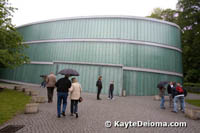 A couple quarrymen found the bones in a cave where they were mining limestone. After the most obvious human remains were removed, the digging continued and the site was buried under tons of gravel, its exact location forgotten. The Neanderthal bones made their way to the Rhine Province Museum in Bonn in 1877, but in 1937 a small Pre-History Museum was opened near the location of the original discovery. It went through various incarnations until a brand new building was opened in 1996 on a nearby site.
A couple quarrymen found the bones in a cave where they were mining limestone. After the most obvious human remains were removed, the digging continued and the site was buried under tons of gravel, its exact location forgotten. The Neanderthal bones made their way to the Rhine Province Museum in Bonn in 1877, but in 1937 a small Pre-History Museum was opened near the location of the original discovery. It went through various incarnations until a brand new building was opened in 1996 on a nearby site.
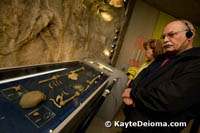 In 1997, archaeologists once again uncovered the original site. In 1997 and 2000 they recovered more bone fragments that matched the 1856 male skeleton, as well as additional remains of a woman and child. These original artifacts, along with replicas of the 1856 discoveries, are on display in the museum.
In 1997, archaeologists once again uncovered the original site. In 1997 and 2000 they recovered more bone fragments that matched the 1856 male skeleton, as well as additional remains of a woman and child. These original artifacts, along with replicas of the 1856 discoveries, are on display in the museum.
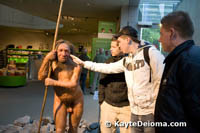 For its 10-year anniversary in 2006, the museum’s permanent exhibit was completely redone, using state-of-the-art technology to create the most accurate depictions yet of what Neanderthal man, woman and child most likely looked like and how they lived.
For its 10-year anniversary in 2006, the museum’s permanent exhibit was completely redone, using state-of-the-art technology to create the most accurate depictions yet of what Neanderthal man, woman and child most likely looked like and how they lived.
Neanderthal Man is not the only focus of the museum. The oval glass building in the woods houses the history of man’s evolution from 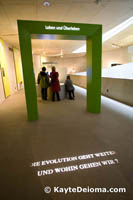 4 million years ago in Africa through today. You proceed from the lower level up a spiraling ramp through time. Themed exhibits includeLiving and Surviving, Tools and Knowledge, Myths and Religion, Nutrition and Environment, and Communication and Society.
4 million years ago in Africa through today. You proceed from the lower level up a spiraling ramp through time. Themed exhibits includeLiving and Surviving, Tools and Knowledge, Myths and Religion, Nutrition and Environment, and Communication and Society.
Although the whole timeline is covered, you actually start with the Neanderthal discoveries on the first level. Original bone fragments are laid out into the Neanderthal Man’s skeleton. Life 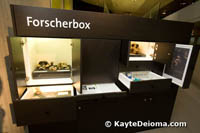 size models of Neanderthal men and women wouldn’t stand out too much in a crowd of modern-day humans.
size models of Neanderthal men and women wouldn’t stand out too much in a crowd of modern-day humans.
Big black Forscherboxes (research boxes) provide lots of compartments and drawers for curious visitors to open, revealing more artifacts, documents and research tools of archaeologists and forensic anthropologists. On the back side of each Forscherbox, computer touch screens provide an additional opportunity for further investigation on the subject, if you happen to speak German.
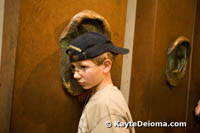 An audio exhibit of giant ears challenges the listener to imagine what cold or a cloud sounds like. To recreate the sensation of being in a grotto, you can stick your head up inside a cave-simulator suspended from the ceiling and look at cave
An audio exhibit of giant ears challenges the listener to imagine what cold or a cloud sounds like. To recreate the sensation of being in a grotto, you can stick your head up inside a cave-simulator suspended from the ceiling and look at cave 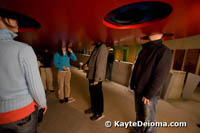 paintings projected on the walls. Kids will be tempted to climb up inside the cave-simulator, but don’t let them. The whole thing is hanging on a few screws and isn’t designed to hold weight.
paintings projected on the walls. Kids will be tempted to climb up inside the cave-simulator, but don’t let them. The whole thing is hanging on a few screws and isn’t designed to hold weight.
Comparisons of Neanderthal man’s bones with modern man’s bones, shows that he was physically stronger than his modern-day counterpart. A side-by-side presentation of our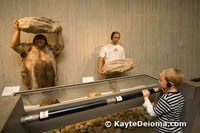 fur-clad ancestor with an Adidas-adorned 21st century German illustrates the relative strength of the two.
fur-clad ancestor with an Adidas-adorned 21st century German illustrates the relative strength of the two.
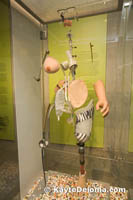 On the upper level is an interesting technology timeline. It shows the progression of technology from a fire flint to a Bic lighter; from a basic bore to a power drill, from a primitive needle and thread to a sewing machine. You can also see the present and future of human evolution with prosthetic limbs and other mechanical replacement parts for the body in use today.
On the upper level is an interesting technology timeline. It shows the progression of technology from a fire flint to a Bic lighter; from a basic bore to a power drill, from a primitive needle and thread to a sewing machine. You can also see the present and future of human evolution with prosthetic limbs and other mechanical replacement parts for the body in use today.
If it’s not raining too hard, or if you brought along your rain<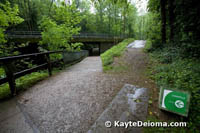 poncho and umbrella, like I did, you can visit the outdoor exhibits. In 2002, three trails were officially added to the museum presentation. The first, marked by green cubes, is theDiscovery Site. It is the shortest trail, just under a quarter mile from the museum. It is the only one on the same side of the street, heading to the right out the front door. The paved trail takes you along the Duessel River to the spot where the bones were found in 1856 and again in 1997 and 2000.
poncho and umbrella, like I did, you can visit the outdoor exhibits. In 2002, three trails were officially added to the museum presentation. The first, marked by green cubes, is theDiscovery Site. It is the shortest trail, just under a quarter mile from the museum. It is the only one on the same side of the street, heading to the right out the front door. The paved trail takes you along the Duessel River to the spot where the bones were found in 1856 and again in 1997 and 2000.
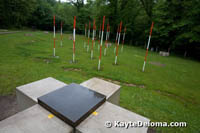 The cave has long since been reduced to quarry dust, and the site on the bank of the river has been replanted with grass and trees, although quarry work continues just over the hill. The Discovery Site (Fundstelle) is marked with red poles and surrounded by concrete crosses with text panels in the middle and plugs for your audio guide. I didn’t realize the audio trail continued outdoors, so I had already turned mine in, but I don’t think I would have wanted to plug in to a wet outlet anyway. The Discovery Site is a limited access area included with museum admission.
The cave has long since been reduced to quarry dust, and the site on the bank of the river has been replanted with grass and trees, although quarry work continues just over the hill. The Discovery Site (Fundstelle) is marked with red poles and surrounded by concrete crosses with text panels in the middle and plugs for your audio guide. I didn’t realize the audio trail continued outdoors, so I had already turned mine in, but I don’t think I would have wanted to plug in to a wet outlet anyway. The Discovery Site is a limited access area included with museum admission.
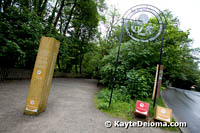 Across the street from the museum, two additional trails are marked out with red and yellow cubes. The yellow cubes mark the Menschenspuren (Human Traces) Trail, which leads to a series of sculptures on prehistoric themes by international artists. At the far end of this loop trail is the Game Reserve, with animals such as brumbies, wisents and aurochs that have been bred to be a close approximation of their ice age counterparts. It is recommended that you allow at least 90 minutes to complete the loop trail. The Human Traces Trail and Game Reserve are open access areas that do not require museum admission and are not restricted to museum hours.
Across the street from the museum, two additional trails are marked out with red and yellow cubes. The yellow cubes mark the Menschenspuren (Human Traces) Trail, which leads to a series of sculptures on prehistoric themes by international artists. At the far end of this loop trail is the Game Reserve, with animals such as brumbies, wisents and aurochs that have been bred to be a close approximation of their ice age counterparts. It is recommended that you allow at least 90 minutes to complete the loop trail. The Human Traces Trail and Game Reserve are open access areas that do not require museum admission and are not restricted to museum hours.
The red cubes lead to the Steinzeit Werkstatt (Stone Age Workshop), also along the loop trail, where workshops and demonstrations are conducted in pre-historic skills. Pre-registration is required for activities at the Stone Age Workshop.
Information panels are in German and English, and there is an English version of the audio guide included with admission. The audio guide is a headset with a cord that you can plug into selected exhibits you want to hear more about. If your kids happen to speak German, there is a special audio guide for kids that is currently only in German. Outlets for the children’s recording are marked with a sticker. If your kids don’t speak German, the adult English version is fine for kids too. In addition to the audio guides, English tours can be arranged with advance notice for an additional fee.
The Neanderthal Museum
Talstr. 300
40822 Mettmann
Phone: (49) (2104) 979715
Fax: (49) (2104) 979724
www.neanderthal.de
